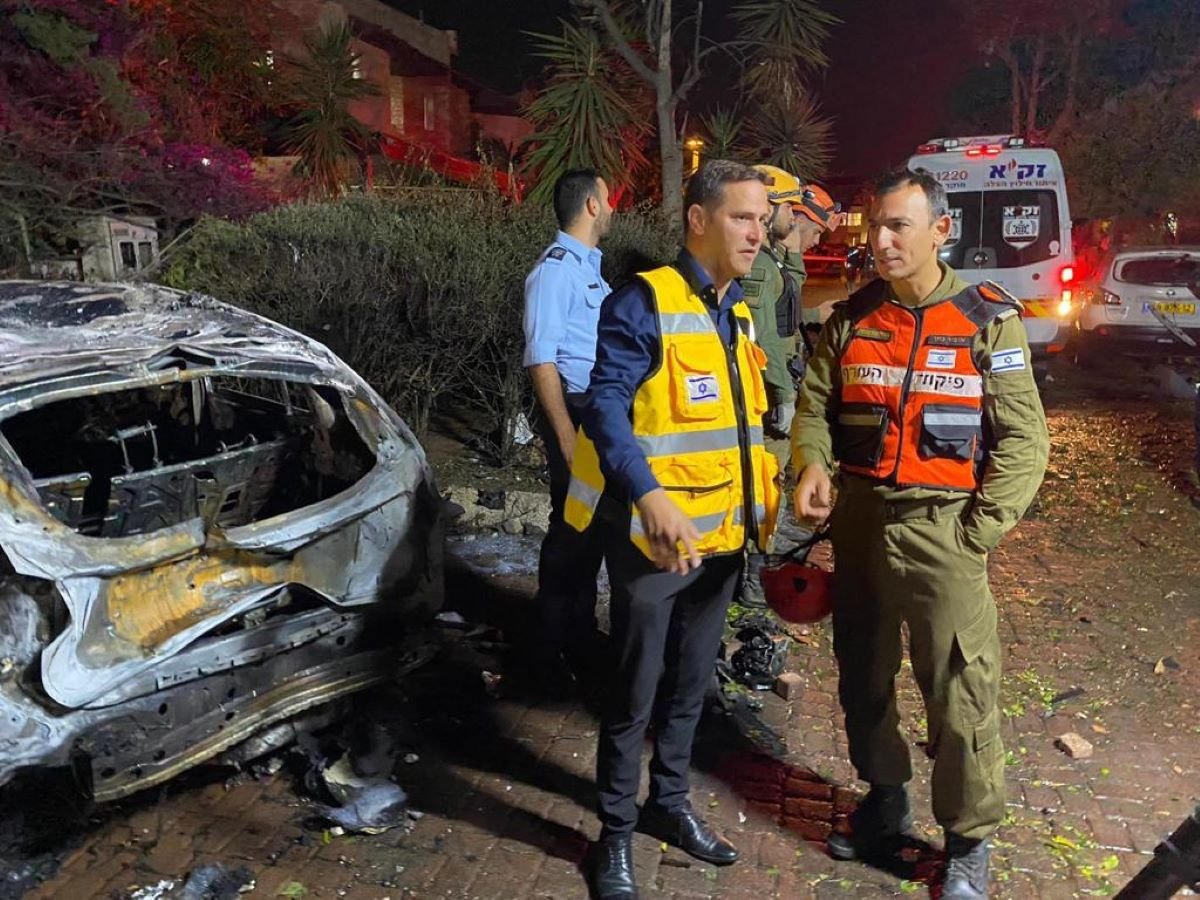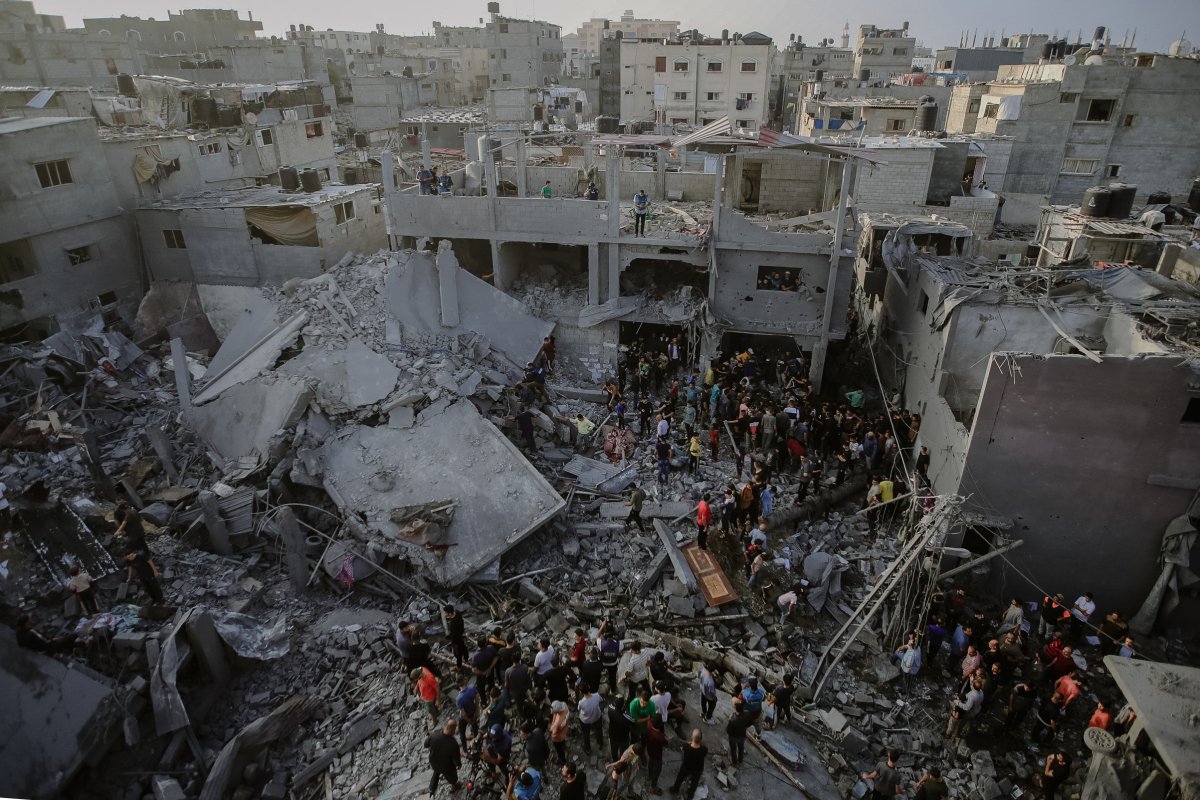As Israel-Hamas War Rages, There’s No Escape from Fighting for Civilians
As the Israel Defense Forces (IDF) clash with Hamas in the Gaza Strip, civilians on both sides continue to be attacked on a daily basis.
For IDF reserve Colonel Ofir Cohen, a senior Home Front Command official now tasked with managing emergency responses to rocket attacks in one of Israel’s most-targeted areas, October 7 began like any other Jewish holiday before reports emerged of what would be an unprecedented surprise attack conducted by Hamas and other Palestinian factions.
“The war caught up with me in my civilian life, on Saturday morning—when I started receiving alerts on my phone that there was a rocket attack on Israel, I immediately understood that this was an unusual event, and within a few moments I put on my uniform and got to the district headquarters as soon as I could,” Cohen told Newsweek.

Israel Defense Forces
“On the way,” he added, “I received reports of damage to homes located in my district—damage to the homes of innocent people who were in their homes even before they got up in the morning for their departure to the synagogues for Simchat Torah celebrations.”
What ensued, according to Cohen, was “something unique” for a nation that has faced and waged numerous wars in its 75-year history. “We didn’t have anything like that from the day this country was born.”
And yet within a few hours of the initial Hamas-led air, land and sea assault, Cohen said the IDF had mobilized to activate measures to protect civilians and assist evacuees whose homes had been destroyed. Now, 42 days into the conflict, the mission continues.
Shfela is a hilly region in central Israel that borders the West Bank, which is partially administered by the secular Palestinian National Authority and partially administered by Israel, and the corridor to the disputed holy city of Jerusalem. But Shfela is also well in the range of rockets fired from Hamas-run Gaza and Cohen said that the region, which includes the city of Rishon LeZion, has experienced some 500 air alerts since the war began.
When one of these rockets manages to evade Israel’s overworked Iron Dome defense system and land a successful blow, Cohen said the immediate response is to mobilize a rescue battalion to the scene of the attack. First responders, which, unlike many other countries, consist of military personnel, “go from zero to 100,” he explained, to facilitate rescue efforts, provide medical assistance and move civilians out of harm’s way.
Sometimes, however, finding immediate safety is a major challenge, and in that case, the mission is to equip civilians “with knowledge that may save lives, and the Home Front Command is working to distribute its warnings in a wide variety of languages and means of distribution,” Cohen said.
“An example of this is a particular incident in Rishon, it refers to a building that does not have a shelter,” Cohen said. “The residents of the building obeyed the instructions and as soon as the alarm sounded, they went down to the lower floor in the stairwell and some of them ran to the public shelter in the street.”
“These actions saved their lives,” he added. “Knowledge is power and when we succeed in enriching the knowledge of the citizens of Israel, human lives are saved as a result. This is one of our small victories in the war that gives us motivation to continue to act to the best of our abilities.”
The scope of the aerial defense challenge Israel has faced since October 7 was demonstrated by a map shared last week by the IDF, which showed the sites of rocket, missile and drone attacks spanning the entire country, from the occupied Shebaa Farms near the Lebanese and Syrian borders in the north to the southern Red Sea port city of Eilat.
The conditions for Palestinians living in densely populated Gaza are even more dire.
Following the deadliest Hamas-led attack in which Israeli officials estimated some 1,200 people, mostly civilians, were killed in Israel on October 7, the IDF began its heaviest-ever bombardment of Gaza, followed by a ground incursion launched on October 19. The Palestinian Health Ministry in the Hamas-run territory has estimated that over 11,500, including more than 4,600 children and more than 3,100 women, have been killed so far in the ongoing Israeli operation.
Newsweek was unable to independently verify these figures or claims by both sides regarding individual attacks.
The IDF has repeatedly stated that it made efforts to avoid civilian casualties but has accused Hamas of using human shields and utilizing protected sites such as hospitals for military operations. Hamas has denied the claims and has accused Israeli forces of attacking non-military infrastructure, including that used by international organizations such as the United Nations Relief and Works Agency for Palestine Refugees in the Near East (UNRWA).
“The Gaza area is an open area and the occupation forces can destroy everything in it, including bunkers, hospitals and shelter centers,” Hamas spokesperson Ghazi Hamad told Newsweek. “They actually carried that out and killed hundreds while they were taking shelter in the centers run by UNRWA.”
UNRWA has said it lost at least 102 of its staff since the conflict began, the highest number of U.N. aid workers killed in any conflict.

SAID KHATIB/AFP/Getty Images
Meanwhile, Hamad argued that Hamas was making an active effort to safeguard Palestinians that the IDF has accused the group of deliberately putting in harm’s way. He said Israel’s advanced arsenal and the scope of the destruction complicated the mission.
“For our part, we are working to protect our Palestinian people by all means, but Israel is using advanced technologies and American weapons to strike all places in the Gaza Strip,” Hamad said. “We work with all entities operating in the Gaza Strip and provide them with all facilities to work in the Gaza Strip.”
“Unfortunately,” he added, “Israel is committing triple crimes: murder and destruction—starvation and fuel deprivation—preventing treatment by targeting hospitals.”
International rescue and medical organizations have also struggled to cope with the wartime conditions.
In the words of Nebal Farsakh, a spokesperson for the Palestinian branch of the International Federation of Red Cross and Red Crescent Societies (IFRC), “There is no safe place in Gaza.”
“People who have left their homes under the evacuation orders from Israeli occupation forces simply sought refuge at hospitals, and many Palestinians have already lost their lives because they didn’t have any access to hospitals or to medical care services,” Farsakh told Newsweek.
Those who leave their homes seeking shelter, she asserted, risk being targeted on sight. And she argued this danger was compounded for rescue and medical personnel.
“The situation for emergency medical services is even harder,” Farsakh added, “because basically paramedics, ambulances are in danger of losing their life every single second because of Israeli occupation forces targeting paramedics and healthcare workers.”
She said that the Palestine Red Crescent has already lost four personnel in the line of duty since the war began, with 23 more injured and 10 ambulances put out of service as a result of Israeli strikes.
While Farsakh did not directly address the extent of the relationship between civilian first responders and Hamas, she challenged the notion that there was any Israeli justification for the targeting of medical facilities or healthcare workers.
“The Palestine Red Crescent is a humanitarian organization,” Farsakh said. “We are the lead emergency medical service provider in the occupied Palestinian territory. We are a member of the IFRC and we believe in humanity, neutrality and impartiality.”
“Unfortunately,” she added, “we are also under constant attacks and under constant threats of losing lives of paramedics, doctors and healthcare workers.”

MOHAMMED ZAANOUN/Middle East Images/AFP/Getty Images
The IDF has justified military operations against medical facilities by alleging that sites such as Shifa Hospital, Gaza’s largest medical facility that is currently being raided by Israeli forces, were being used by Hamas as cover for vast underground tunnel networks housing weapons and command and control centers. The IDF has so far released footage showing what it claimed were tunnel shafts near Shifa and Rantisi hospitals, as well as some weapons and equipment at the two sites. Hamas has rejected the findings as false.
A compilation of video clips put together by the IDF purporting to show footage collected from the bodies of Hamas fighters amid the October 7 assault also showed what appeared to be Palestinian fighters targeting Israeli civilians and soldiers alike, and intentionally incapacitating a parked ambulance.
With the U.N. repeatedly urging both sides to avoid targeting civilians, the U.N. Security Council adopted on Wednesday its first resolution on the conflict, calling for all parties to ensure civilian safety in Gaza, reach “urgent and extended humanitarian pauses” and to allow for the unconditional release of more than 200 hostages believed to be held by Hamas and other Palestinian factions.
The Malta-sponsored resolution was passed 12-0 among the 15-member body, with three permanent members, Russia, the United Kingdom and the United States, abstaining.
Israel’s representative rejected the resolution as “detached from the reality on the ground” and failing to condemn Hamas, whose surrender he argued would only bring an end to the war. The Palestinian representative argued that the international community should have called for a full ceasefire a long time ago and this marked a “small and modest resolution.”
The U.N. Security Council resolution, which followed an earlier October 26 U.N. General Assembly resolution calling for an immediate “humanitarian truce” that passed 120-14 with 45 abstentions, came a day after Stephane Dujarric, spokesperson for U.N. Secretary-General António Guterres, said the U.N. chief “calls for an immediate humanitarian cease-fire” in the conflict.
Uncommon Knowledge
Newsweek is committed to challenging conventional wisdom and finding connections in the search for common ground.
Newsweek is committed to challenging conventional wisdom and finding connections in the search for common ground.

Comments are closed.